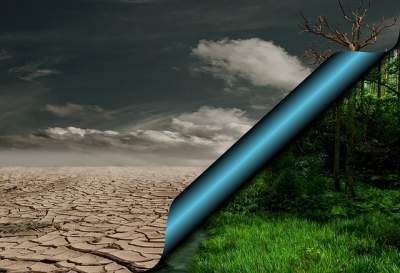Image by Elden Miller from Pixabay
With atmospheric CO2-equivalent greenhouse gas concentrations now above 500 ppm and average global warming approaching 1.5oC, there is a clear shift in the world’s climate zones, displayed for example on maps of the expanding wet tropical zones, drying sub-tropical latitudes and polar-ward migration of temperate climate zones. Large parts of southern Europe are suffering from droughts, heat waves and fires, the Kalahari Desert is encroaching southward and much of southern Australia is affected by warming and droughts. And yet the world’s governments and media fail to accord these problems the priority they merit.
Global warming has reached a mean of nearly ~1.5 oC, or ~2.0oC when the masking effects of sulphur dioxide and other atmospheric aerosols are considered, and by a mean of ~2.3oC in the Polar Regions. This has caused expansion of the warm tropical latitudes and the pole-ward migration of climate zones resulting in large scale droughts in subtropical latitudes such as parts of inland Australia and southern Africa. A similar trend is taking place in the northern hemisphere where the Sahara desert is expanding northward, with consequent heat waves across the Mediterranean and Europe.
In southern Africa ‘[w]idespread shifts in climate regimes are projected, of which the southern and eastern expansion of the hot desert and hot steppe zones is most prominent. From occupying 33.1 and 19.4 % respectively of southern Africa under present-day climate, these regions are projected to occupy between 47.3 and 59.7 % (hot desert zone) and 24.9 and 29.9 % (hot steppe zone) of the region in a future world where the global temperature has increased by 3°C.’
Closely linked to the migration of climate zones is the southward drift of Antarctic-sourced cold moist fronts which sustain seasonal rain in south-west and southern Australia. A feedback loop has developed where deforestation and decline in vegetation in southern parts of the continent result in the rise of thermal plumes of dry air masses that deflect the western moist fronts further to the southeast.
Since 1979 the planet’s tropics have been expanding poleward by 56 km to 111 km per decade in both hemispheres, leading one commentator to call this Earth’s bulging waistline. Future climate projections suggest this expansion is likely to continue, driven largely by human activities – most notably emissions of greenhouse gases and black carbon, as well as warming in the lower atmosphere and the oceans.
An analysis of the origin of Australian droughts suggests, according to both observations and climate models, that at least part of this decline is associated with changes in large-scale atmospheric circulation, including shrinking polar ice and a pole-ward movement of polar-originated westerly wind spirals, as well as increasing atmospheric surface pressure over parts of southern Australia. Simulations of the future climate with this model suggest amplified winter drying over most parts of southern Australia in the coming decades in response to changes in radiative forcing. The drying is most pronounced over southwest Australia, with total reductions in austral autumn and winter precipitation of approximately 40% by the late twenty-first century. Thus rainfall in southwestern Australia has declined sharply from about 1965 onward, concomitant with the sharp rise of global temperatures.
The consequences of the migration of climate zones are compounded by changes in flow patterns of river systems, for example major rivers in southern Asia, the Indus, Ganges, and Brahmaputra river basins, the home and bread basket for more than a billion people. With warming, as snow cover of mountain terrains where rivers originate is reduced, melting and flow are enhanced and floods ensue, in particular during the Monsoon. For example, in 2010 approximately one-fifth of Pakistan’s total land area was affected by floods, directly affecting about 20 million people, with a death toll close to 2,000. Such changes in climate and geography can only be enhanced once sea level rise increases from the scale of tens of centimetres as at present to metres, as predicted to take place later this and next century.
None of the above appears to constitute a priority on the part of the world’s parliaments, having to all intents and purposes given up on the future habitability of large parts of the Earth and on future generations.
Article reposted with permission from the author.
Author
Dr Andrew Glikson, an Earth and paleoclimate scientist, is a Visiting Fellow at the School of Archaeology and Anthropology, Australian National University, where he is reviewing the effects of climate on prehistoric human evolution. He is also an Honorary Professor at the Center for Excellence in Geothermal Research, The University of Queensland, and is affiliated with the Climate Change Institute and the Planetary Science Institute, Australian National University.
He graduated at the University of Western Australia in 1968, conducted geological surveys in central and western Australia and became a Principal Research Scientist with the Australian Geological Survey Organization (now Geoscience Australia).





